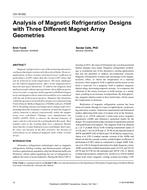Description
Magnetic refrigeration is one of the promising alternative cooling technologies in terms of its theoretical limits. However, applications of these systems yield much lower coefficient of performance (COP) values than the Carnot COP values that can be achieved at room temperatures. The main challenges are the limited magnetocaloric effect of the magnetocaloricmaterial and space limitations. To address the magnetic field and heat transfer enhancement problems, three different geometries (circular, octagonal, and hexagonal) of Halbach magnetarray and magnetocaloric material assemblies were simulatedwith the aid of theoretical analysis. Magnetic flux intensities within the apertures of each hollow design were obtained using Finite Element Method Magnetics (FEMM) software (FEMM2013). Resulting entropy and temperature changes and corresponding heat flux boundary conditions around the magnetocaloricmaterial is placed concentrically within the magnetarray were calculated. Findings were implemented intoANSYS (ANSYS 2016) to observe the thermal behavior of water, which is selected as the working fluid in this study. Heat transfer rates to the working fluid were compared. Results show that the circular Halbach arrays yield higher heat transferrates, not because of the flow structure, but because of achievement of an enhanced magnetic field within circular arrays.
Citation: 2018 Winter Conference, Chicago, IL, Technical Papers
Product Details
- Published:
- 2018
- Number of Pages:
- 10
- Units of Measure:
- Dual
- File Size:
- 1 file , 2.2 MB
- Product Code(s):
- D-CH-18-002




